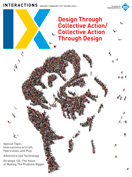Authors:
Loren Terveen
The events and activities you know and love in the SIGCHI community—the CHI conference, the other 20-plus SIGCHI-sponsored conferences, special workshops, and so on—are all volunteer-driven. Volunteers plan, organize, and run these activities (with great help from professional staff at ACM and vendors). This means that any problems with our volunteer ethos and structures endanger the fabric of our community.
It is getting more difficult to fill volunteer roles at SIGCHI conferences.
We do face some troubling signs:
- People in our community are enthusiastic about pursuing new topics and opportunities. That's why SIGCHI sponsors 24 conferences. However, each conference has many volunteer roles that must be filled, some of which demand significant effort. It is getting more difficult to fill these spots. This is especially true for unglamorous roles: It can sometimes be easier to find someone to be papers chair than publicity chair.
- To complicate matters, the selection process for volunteer positions is often unclear: How do you qualify for interesting and rewarding jobs? How do community-minded people get started and advance on the volunteer-service career path?
- People in our community are writing more and more papers. From 2006 to 2016, the number of submissions to the CHI conference quadrupled, from 626 to 2,435. Other conferences also show significant increases. Conference attendance, which tracks community affiliation, is also increasing, but more slowly: For example, attendance at CHI is up 50 to 75 percent over the past decade. This makes it difficult to find sufficient reviewers for all these submissions.
The SIGCHI Executive Committee (EC) has begun to take steps to address these concerns through volunteer pipelines, volunteer training, and open processes. First, we appointed Sue Fussell as adjunct chair for career development. In this role, she is developing a database of people who have taken on roles at SIGCHI conferences. This database will assist conference leadership in staffing their committees as well as provide clearer paths for volunteers to follow to gain the experience for leadership positions. Second, the SIGCHI EC has begun holding "How to Be a SIGCHI Volunteer" events at conferences—MobileHCI, RecSys, UIST, and VRST in 2016, with more to come—to talk about service opportunities, answer your questions about how to volunteer, and gather the names of people who are interested in volunteering. Sue has also led the development of career-mentoring events at the CHI conference, with service opportunities a major topic. Third, the SIGCHI EC is also encouraging more transparency and openness in the process of selecting people for leading volunteer roles—for example, with open calls for nominations. Finally, we are seeking to engage more people in our key decision-making processes; we see conference steering committees, including the newly established steering committee for the CHI conference, as an important step in that direction.
What do you think? How can we preserve our volunteer tradition and bring more people into it? Let me know your thoughts at [email protected].
 Further Reading
Further Reading
Cliff Lampe's essay "Why I Love Academic Service": https://medium.com/@clifflampe/why-i-love-academic-service-8c7e4da19092
SIGCHI. "How To Be a Volunteer": http://www.sigchi.org/news/sustaining-our-community
Loren Terveen, President, ACM SIGCHI, [email protected]
Copyright held by author
The Digital Library is published by the Association for Computing Machinery. Copyright © 2017 ACM, Inc.








Post Comment
No Comments Found